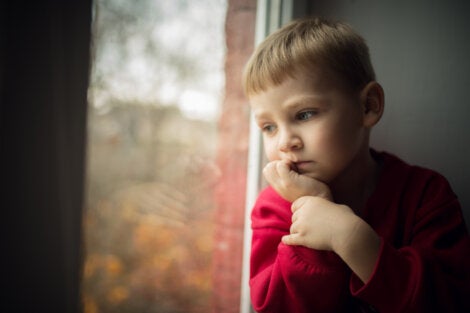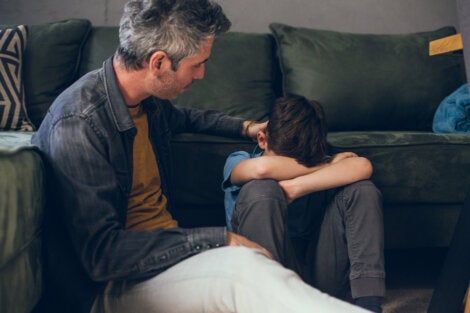Talking to a Child About Death


Written and verified by the psychologist Laura Ruiz Mitjana
How should you go about talking to a child about death? Before we answer the question, it’s important to bring up another concept: grief and experiencing death or loss. Grief is a complex process that people experience when they lose a loved one, experience a breakup, lose a job, or become disabled in some way. It’s a process of reorganizing and rebuilding reality in a way that allows you to adapt to life after loss.
In this article, we’ll talk about how to talk to a child about death using advice and recommendations from the Catalan Pediatric Society and the Parc Tauli de Sabadell Hospital. As you’ll see, the guidelines vary somewhat depending on age, since children’s concepts of death and dying changes as they grow and develop.
Firstly, we’ll explain the developmental phases according to children’s age range (in terms of psychological and social development, language, autonomy, etc.) and then talk about how they understand death at each stage and how to explain the death of a loved one. It’s important to understand children’s development in order to know what kind of language is age-appropriate and what you should avoid.
“While grief is fresh, every attempt to divert it only irritates. You must wait till it be digested, and then amusement will dissipate the remains of it.”
-Samuel Johnson-

Early childhood
Early childhood is the period from birth to two years. In this stage of life, a child’s life revolves around the routines of daily life, and attachment to caregivers is crucial.
At two years old, language development is in full swing. Children can understand and say words that have to do with their daily lives. They can feel and express basic emotions, such as pleasure or anger, through their behavior.
What’s grief like in early childhood? A two-year-old child doesn’t understand death. The loss of a primary caregiver will deeply affect the child, though they don’t understand what’s happening. Consequently, it’s very important to continue with the child’s daily routine as much as possible. The day-to-day care should be carried out by a primary caregiver, if at all possible.
Keep in mind that intense emotional expression by the adult can upset the child. As we mentioned above, children express their emotions through their behavior, not language, until about the age of two.
As you can see, grief in early childhood is unique. Keep in mind that it’s vitally important for the child to continue to feel safe and cared for. They should have as much contact with the normal people in their lives as possible.
How to talk to a young child about death
Although young children have very limited understanding about death, it’s still important to talk to them about it. If the child is talking, use simple language and speak in short sentences. Deliver the news clearly and calmly. Make them feel as safe as possible. The main caregiver should tell the child in a space that’s comfortable and safe for them.
Whatever adult is tasked with breaking the news should make sure they have their own emotions under control before sharing it with the child. After hearing the news, the child might simply go back to playing. Going “back to normal” is key at this stage.
3-5 years old (preschool age)
How do you talk about death with a 3-5-year-old child? First, let’s talk about their development at that age. Between three and five, children tend to be restless and curious. They become more independent and demand more autonomy. Children at this stage of life might start to be afraid of certain things, and engage in fantasy play. Language skills are solidified.
On a cognitive level, they’re quite egocentric. They can only understand the world through their own experiences. On the other hand, when they interpret events, their thinking is somewhat flexible and magical.
According to the experts, children at this age don’t understand that death is universal and everyone will die. They have an idea that death is reversible. Their magical thinking makes it easy to confuse a thought for a fact. They might believe, for example, that, if they think about death, it’ll happen.
How to explain death to a 3-5-year-old
According to the Catalan Society of Pediatrics, you should offer a concrete a real explanation based on their daily life and experience. Tell them in a safe space when they’re calm.
Share the news as soon as possible. You don’t need to wait. Finally, be sure to make time for questions and doubts your child might have.
Talking to a child about death: 6-9 years
At this stage, children are boldly asserting their autonomy, and their language is fully developed. They talk about and understand more abstract and symbolic concepts. In addition, their thinking is flexible and reflexive and they’re very curious. Finally, at this age, most children can tell the difference between reality and fantasy.
This is the stage when children start to understand that death is final. They also have the cognitive ability to understand that the body stops working when we die. Children aged 6-9 still can’t understand the idea of their own death, but they worry about someone close to them dying.
How to explain
At this stage, it’s vitally important that you don’t try to sugarcoat the truth or use metaphors. That can frustrate and confuse them. During this stage, it’s normal for children to ask a lot of questions, so be prepared to answer them clearly and honestly.
Share the news in a clear, real, and brief way. Tell them as soon as you’re able.
10-13 years (pre-adolescence)
During this stage of life, children start to experience the changes of puberty. Their mastery of language is complete, and their thinking allows them to use logic and reason even in abstract situations. They can identify and express complex emotions (disappointment, for example). Also, they understand that different emotions can exist at the same time.
During pre-adolescence, the concept of death is now fully developed. As a result, children understand the following:
- Death is final.
- The body stops working.
- Everyone dies.
- They’re scared of loss.
How to explain
How should you talk about death to a pre-adolescent? Well, just like the other stages, your explanation should be clear, brief, and honest.
Find a calm, comfortable environment to share the news. Make sure the child feels comfortable expressing their feelings and communicating whatever questions they might have. Let them know that they can ask you anything.

Adolescence
Finally, we reach adolescence. This is a stage marked by changes, in every sense of the word. Most teens start asserting their independence as they develop their self-concept and a more accurate idea of their environment. Consequently, adolescents experience grief very differently from children or adults.
Teenagers can be especially vulnerable, which means that loss during this stage tends to be significant. They’ve had time to forge a relationship with the person who’s passed away. In addition, they’re able to understand the meaning of death.
What does grief look like for teens? Its intensity varies depending on what kind of relationship they had with the person, the circumstances of their death, whether or not they were able to say goodbye, etc.
How to break the news
In this sensitive stage, it’s important to explain what happened very carefully. Ideally, the person closest to the teen will be the one to tell them. It should be in a comfortable, private space. Tell them as soon as possible. Be honest and concise, respect their space, and let them know you’re there to answer any questions.
All cited sources were thoroughly reviewed by our team to ensure their quality, reliability, currency, and validity. The bibliography of this article was considered reliable and of academic or scientific accuracy.
- Parc Taulí de Sabadell, Hospital Universitari. (2020). El dol en les diferents etapes. Equip de Psicologia Clínica del Servei de Salut Mental Infanto-juvenil de la Corporació Sanitària Parc Taulí de Sabadell.
- Societat Catalana de Pediatria (www.sccpediatria.cat)
This text is provided for informational purposes only and does not replace consultation with a professional. If in doubt, consult your specialist.








